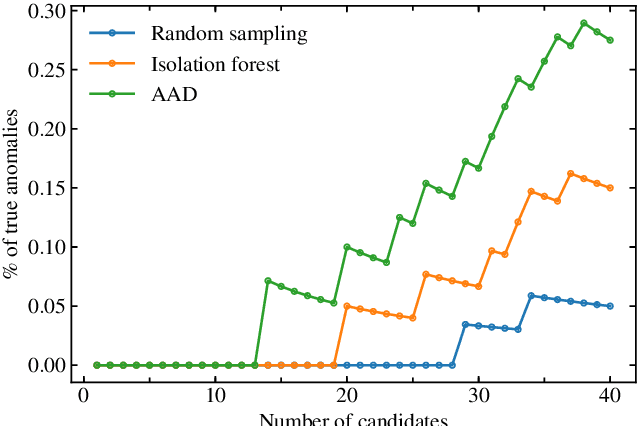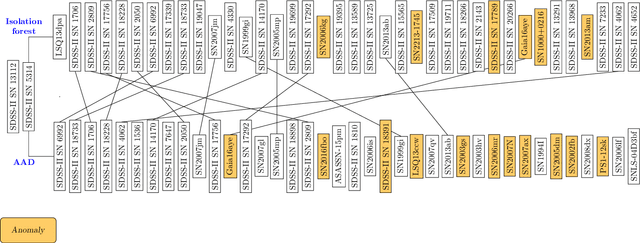Matwey V. Kornilov
What ZTF Saw Where Rubin Looked: Anomaly Hunting in DR23
Jul 08, 2025Abstract:We present results from the SNAD VIII Workshop, during which we conducted the first systematic anomaly search in the ZTF fields also observed by LSSTComCam during Rubin Scientific Pipeline commissioning. Using the PineForest active anomaly detection algorithm, we analysed four selected fields (two galactic and two extragalactic) and visually inspected 400 candidates. As a result, we discovered six previously uncatalogued variable stars, including RS~CVn, BY Draconis, ellipsoidal, and solar-type variables, and refined classifications and periods for six known objects. These results demonstrate the effectiveness of the SNAD anomaly detection pipeline and provide a preview of the discovery potential in the upcoming LSST data.
Exploring the Universe with SNAD: Anomaly Detection in Astronomy
Oct 24, 2024Abstract:SNAD is an international project with a primary focus on detecting astronomical anomalies within large-scale surveys, using active learning and other machine learning algorithms. The work carried out by SNAD not only contributes to the discovery and classification of various astronomical phenomena but also enhances our understanding and implementation of machine learning techniques within the field of astrophysics. This paper provides a review of the SNAD project and summarizes the advancements and achievements made by the team over several years.
* 14 pages, 4 figures
Active Anomaly Detection for time-domain discoveries
Sep 29, 2019

Abstract:We present the first application of adaptive machine learning to the identification of anomalies in a data set of non-periodic astronomical light curves. The method follows an active learning strategy where highly informative objects are selected to be labelled. This new information is subsequently used to improve the machine learning model, allowing its accuracy to evolve with the addition of every new classification. For the case of anomaly detection, the algorithm aims to maximize the number of real anomalies presented to the expert by slightly modifying the decision boundary of a traditional isolation forest in each iteration. As a proof of concept, we apply the Active Anomaly Discovery (AAD) algorithm to light curves from the Open Supernova Catalog and compare its results to those of a static Isolation Forest (IF). For both methods, we visually inspected objects within 2% highest anomaly scores. We show that AAD was able to identify 80% more true anomalies than IF. This result is the first evidence that AAD algorithms can play a central role in the search for new physics in the era of large scale sky surveys.
Maximum likelihood estimation for disk image parameters
Jul 24, 2019



Abstract:We present a novel technique for estimating disc parameters from its 2D image. It is based on the maximal likelihood approach utilising both edge coordinates and the image intensity gradients. We emphasise the following advantages of our likelihood model. It has closed-form formulae for parameter estimating, therefore requiring less computational resources than iterative algorithms. The likelihood model naturally distinguishes the outer and inner annulus edges. The proposed technique was evaluated on both synthetic and real data.
 Add to Chrome
Add to Chrome Add to Firefox
Add to Firefox Add to Edge
Add to Edge